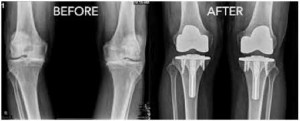Total Knee Replacement Surgery
 Knee replacement is surgery for people with severe knee damage. Knee replacement can relieve pain and allow you to be more active. When you have a total knee replacement, the surgeon removes damaged cartilage and bone from the surface of your knee joint and replaces them with a man-made surface of metal and plastic. In a partial knee replacement, the surgeon only replaces one part of your knee joint. The surgery can cause scarring, blood clots, and, rarely, infections. After a knee replacement, you will no longer be able to do certain activities, such as jogging and high-impact sports.
Knee replacement is surgery for people with severe knee damage. Knee replacement can relieve pain and allow you to be more active. When you have a total knee replacement, the surgeon removes damaged cartilage and bone from the surface of your knee joint and replaces them with a man-made surface of metal and plastic. In a partial knee replacement, the surgeon only replaces one part of your knee joint. The surgery can cause scarring, blood clots, and, rarely, infections. After a knee replacement, you will no longer be able to do certain activities, such as jogging and high-impact sports.
Preparation
- Avoid certain medications. Your doctor may want you to avoid taking medications or dietary supplements that can increase your risk of bleeding.
- Fast beforehand. Depending on the type of anesthesia you’ll have, your doctor may want you to avoid eating, and drinking eight hours before your procedure.
- Arrange for a ride. You won’t be allowed to drive yourself home after the procedure, so make sure someone will be available to pick you up. If you live alone, ask someone to check on you that evening or, ideally, stay with you the rest of the day.
- Choose loose clothing. Wear loose, comfortable clothing baggy gym shorts, slip on shoes for example, if you’re having knee surgery so you can dress easily after the procedure.
What Happens During Knee Replacement Surgery?
 Once you are under general anesthesia (meaning you are temporarily put to sleep) or spinal/epidural anesthesia (numb below the waist), an 8- to 12-inch cut is made in the front of the knee. The damaged part of the joint is removed from the surface of the bones, and the surfaces are then shaped to hold a metal or plastic artificial joint. The artificial joint is attached to the thigh bone, shin and knee cap either with cement or a special material. When fit together, the attached artificial parts form the joint, relying on the surrounding muscles and ligaments for support and function
Once you are under general anesthesia (meaning you are temporarily put to sleep) or spinal/epidural anesthesia (numb below the waist), an 8- to 12-inch cut is made in the front of the knee. The damaged part of the joint is removed from the surface of the bones, and the surfaces are then shaped to hold a metal or plastic artificial joint. The artificial joint is attached to the thigh bone, shin and knee cap either with cement or a special material. When fit together, the attached artificial parts form the joint, relying on the surrounding muscles and ligaments for support and function
Recovery
After knee joint replacement, people are standing and moving the joint the day after surgery. At first, you may walk with the help of parallel bars, and then a walking device — such as crutches, walker, or cane — will be used until your knee is able to support your full body weight. After about six weeks, most people are walking comfortably with minimal assistance. Once muscle strength is restored with physical therapy, people who have had knee joint replacement surgery can enjoy most activities (except running and jumping).
Risks
As with any surgical procedure, complications can occur. Some possible complications may include, but are not limited to, the following:
- Bleeding into the knee joint.
- Damage to the cartilage, meniscus, or ligaments in the knee.
- Formation of a blood clot in the leg.
- Injury to a blood vessel or nerve.
- Infection in the knee joint.
- Knee stiffness following the procedure.
